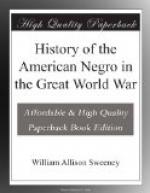“The town that’s always ready to take off its hat and give a whoop for a man who’s done something—’no matter who or what he was before,’ as the old Tommy Atkins song has it—turned itself loose yesterday in welcoming home a regiment of its own fighting sons that not only did something, but did a whole lot in winning democracy’s war.
“In official records,
and in the histories that youngsters will
study in generations
to come, this regiment will probably always be
known as the 369th Infantry,
U.S.A.
“But in the hearts of a quarter million or more who lined the streets yesterday to greet it, it was no such thing. It was the old 15th New York. And so it will be in this city’s memory, archives and in the folk lore of the descendants of the men who made up its straight, smartly stepping ranks.
“New York is not race-proud nor race-prejudiced. That this 369th Regiment, with the exception of its eighty-nine white officers, was composed entirely of Negroes, made no difference in the shouts and flagwaving and handshakes that were bestowed upon it. New York gave its Old 15th the fullest welcome of its heart.
“Through scores of thousands of cheering white citizens, and then through a greater multitude of its own color, the regiment, the first actual fighting unit to parade as a unit here, marched in midday up Fifth Avenue and through Harlem, there to be almost assailed by the colored folks left behind when it went away to glory.
“Later it was feasted and entertained, and this time very nearly smothered with hugs and kisses by kin and friends, at the 71st Regiment Armory. Still later, perfectly behaved and perfectly ecstatic over its reception, the regiment returned to Camp Upton to await its mustering out.
“You knew these dark lads a year and a half ago, maybe, as persons to be slipped a dime as a tip and scarcely glanced it. They were your elevator boys, your waiters, the Pullman porters who made up your berths (though of course you’d never dare to slip a Pullman porter a dime). But, if you were like many a prosperous white citizen yesterday you were mighty proud to grasp Jim or Henry or Sam by the hand and then boast among your friends that you possessed his acquaintance.
“When a regiment has the medal honors of France upon its flags and it has put the fear of God into Germany time after time, and its members wear two gold stripes, signifying a year’s fighting service, on one arm, and other stripes, signifying wounds, on the other, it’s a whole lot different outfit from what it was when it went away. And that’s the old 15th N.Y. And the men are different—and that’s Jim and Henry and Sam.
“Col. William Hayward, the distinguished white lawyer and one time Public Service Commissioner, who is proud to head these fighters, was watching them line up for their departure




